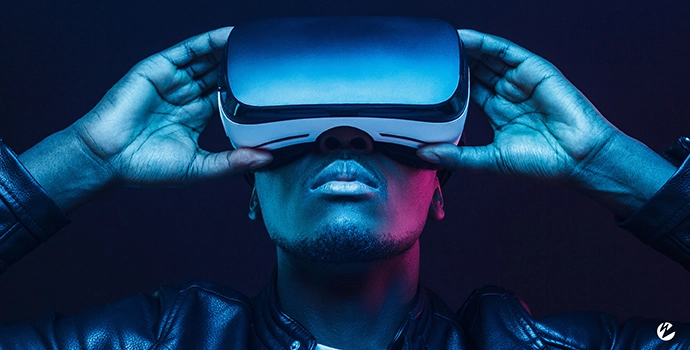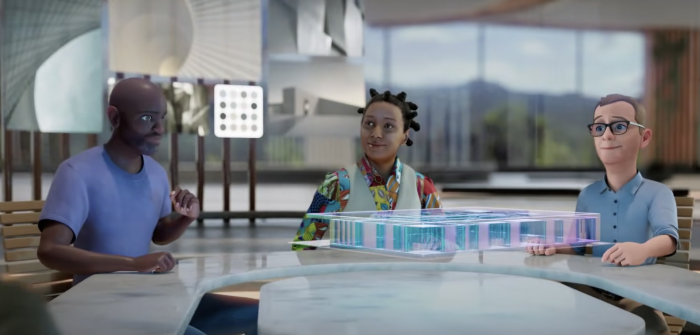The Role of Video in the Metaverse

We’ve been dreaming of the metaverse collectively for quite some time. The Matrix. Ready Player One. Free Guy. Tron. The newer Jumanji movies. We’d be remiss not to mention the novel Snow Crash. Each of these stories explores something that’s been on humanity’s horizon since people were able to interact digitally: virtual worlds the size of our own.
Is that time finally here in the form of the metaverse? Big tech companies certainly want it to be, and we very well may be at the precipice we’ll remember in a hundred years. However, the metaverse is still too small to tell what exactly it will become. Nevertheless, the combination of streaming and some exciting technological developments to come hints at the ways video will continue to permeate our lives.
Table of Contents
What Is the Metaverse?
First, let’s define “metaverse.” A metaverse is a virtual environment created with extended reality, or XR. XR includes both augmented reality (AR) — think Pokémon Go, which entails adding digital elements to the real world with your phone — and virtual reality (VR), which is an entirely simulated environment you’ll associate with the films listed above (you can also refer to the combination of these as mixed reality, or MR, and the three make XR). The internet of things (IoT), spacial computing, and AI also play a role.
Metaverses are also collective. You can have your own “room” in one, so to speak, but the point is to bring people from anywhere together in shared digital spaces. Metaverses are likely the next generation of the internet the way social media and live video revolutionized the one we know today. Research firm Gartner anticipates that as many as 25% of the population will spend at least an hour a day participating in a metaverse for work, education, shopping, entertainment, or other reasons.
You might have a big question: What’s the difference between a metaverse and the metaverse? There is no singular metaverse yet; big tech companies are currently developing their own virtual worlds that are not integrated. However, Meta, formerly Facebook, has a convenient name that understandably confuses many people due to the corporation’s extensive involvement in metaverse technology. As you can learn from this video, CEO Mark Zuckerberg’s vision is to join metaverses together and make them more interoperable, allowing users to switch between them with ease — effectively creating the next-best thing to a singular metaverse (regardless, it’s common to refer to the technology as “the metaverse”).

How Video Fits In
So, what role does video play in the metaverse? Well, the metaverse is built on video. It may not always seem like it because some applications are just cartoon avatars and graphics replacing people and surroundings, but what is that if not a real-time video game made to overlap with physical reality? Not every component of the metaverse is like two-dimensional live or pre-recorded content, but it’s video nonetheless — just the next step in its evolution.
Let’s look at some ways video makes the metaverse what it is:
Gaming
Gaming is the precursor and facilitator of the metaverse. Just look at the list of movies at the start of this blog post — most of them were about video games you could immerse yourself in so well they were basically reality. Video games have the honor of introducing the world to the idea of multiple players operating in a shared virtual space: World of Warcraft, Second Life, Fortnite, Roblox, and more. The latter two even host “real-life” events where users can “gather” for specific purposes.
Because the metaverse is both the next step in video games and the internet itself, it’s clear that video plays an integral role. AR, VR, and MR are all forms of next-level video, only this time they’re layered over physical reality via devices or 3D enough to pretend they’re real.
Social Events
One of the metaverse’s greatest appeals is that though it’s a video game-like space, you don’t need to have an objective or story like you do in a game — it can simulate real life because you can just… hang out. Remote happy hours with your friends in other cities are fun, but camera fatigue is real, so maybe you’d prefer to meet with each other’s avatars instead.
Several companies are capitalizing on the potential for virtual social gatherings. Warner Bros. hosted a digital party on the Roblox platform to promote its movie In the Heights that featured Latin music and dance. Here’s a cool way Warner Bros. incorporated classic video, though: Party attendees could watch behind-the-scenes interviews and videos, including a dance they could follow along to with the film’s choreographer.
Similarly, a Wowza customer uses classic live streaming in an animated metaverse. As a virtual event company, this organization hosts “discos” at digital nightclubs. Participants are at their computers in real life, but the company live streams real DJs from around the world, letting attendees enjoy new music and interact with each other. Real-time video enables the physical world and the metaverse to cross over with each other regardless of geographical distance.

Language Learning
They say one of the best ways to learn a language is to immerse yourself. Unfortunately, spending time in another country isn’t an option for everyone, so the next-best thing is to converse with fluent speakers remotely. One startup, Immerse, has an even better idea: connecting language learners in the metaverse. Leveraging XR video and real-time audio, Immerse can create scenarios — such as escaping a deserted island or discussing abstract art — that facilitate language practice better than practicing restaurant orders and asking for the bathroom.
Real Estate
Do you want to move homes, but don’t have the time or resources to travel and look at properties in person? Video in the metaverse is an excellent compromise. With a set of VR goggles or glasses, you could watch a 360° live stream of whatever home you’re interested in, exploring it as if you were there. One Wowza customer already leverages this revolutionary kind of video (big companies like JP Morgan Chase are looking to do the same) to sell properties, and who knows? Maybe one day there will be a metaverse where you can tour whole virtual neighborhoods that mimic real-life counterparts as you would a video game, allowing you go enter each home and see real-time video.
Advertising
Even though the metaverse isn’t fully formed yet, advertisers can smell its potential in the air. It didn’t take long for social media to be saturated with ads and influencers, so though video isn’t playing this role quite yet, it’s undeniable that it will be equally pervasive in the metaverse. You might see video ads from countless companies in the near future. Not just the ones you’re used to, either — video marketing could take the form of 3D holograms and XR experiences, too (and to make things outright scary, it’s possible some companies will create technology that captures your eye movements and facial expressions to gauge your reaction when watching their ads).

Challenges With Adoption
If big tech companies like Meta, Apple, Google, and Microsoft want the metaverse to be the next big thing, why isn’t it yet? What’s holding the metaverse back from becoming the next stage of the internet? For starters:
The Scope Is Too Narrow
As of now, most metaverses that exist, like Roblox and Fortnite, are meant for gaming. This pattern makes sense — video games often rely on virtual worlds where players can play in a shared space together — but there aren’t many that aren’t for gaming. Startups like Immerse mentioned previously are still new and gaining traction, but brands that want to leverage metaverse technology need to get the public to stop associating it with video games and embrace broader applications.
It’s More Than Virtual
Like any virtual environment, the technology cannot exist on its own — it needs physical devices to make it possible. AR experiences like Pokémon Go gained popularity because they only require users’ phones they already have, but many other forms of extended reality necessitate headsets (like Meta’s subsidiary Oculus VR), goggles, watches, and other gear that can get expensive.
The public is reluctant to invest in such devices until metaverses truly start offering greater value propositions beyond gaming. Though pieces of XR equipment are evolving rapidly, they still have a long way to go, so it’s possible many people are waiting until they feel the technology is ready to provide the experiences that meet their expectations. Plus, the metaverse heavily depends on strong and stable internet connections, which automatically discounts people who live in places where internet connectivity isn’t guaranteed.

The Metaversal Economy
There’s another elephant taking up a lot of room in the metaverse: crypto. They are not mutually exclusive concepts but it’s understandable why the public perceives them to go hand-in-hand. People who are passionate about one are commonly passionate about (and involved in) the other, so many metaverse projects have some sort of crypto-based internal economy that allows international transactions without currency conversion (like “Mana” in Decentraland).
One of the problems with crypto — besides its environmental impact — is that thanks to its various scandals, people are divided between those who love it and those who mistrust it. The crypto world is a volatile place, so as long as it’s associated with the metaverse, people will have a hard time accepting the latter.
Content Still Rules
Related to its over-emphasis on gaming, the metaverse has a lot of catching up to do regarding the content it offers. As of now, short-form video content still rules: TikTok users spend an average of 95 minutes each day watching videos. It’s easy to both mindlessly scroll and participate in the greater TikTok ecosystem (which often migrate over to Instagram’s similar feature, Reels) by creating your own trendy content, both of which keep users hooked. Not to mention that Facebook’s 1.93 billion daily users dropped significantly earlier this year when they moved over to TikTok — taking an enormous chunk of Meta’s revenue with them.
Overzealousness
Finally, the desire to make the metaverse happen so quickly has resulted in bad investments and mismanagement. Meta attempted a major metaverse project called Reality Labs that ended in disaster (not even the company’s own employees want to use it), losing the company a whopping $10 billion. Mark Zuckerberg didn’t confess that the project factored into his decision to fire 13% of Meta’s workforce. But it’s clear that overzealousness and a lack of understanding of what users want — and how to treat the people building the metaverse itself — didn’t exactly push the concept into the mainstream.
Subscribe and stay up to date
Learn about the latest developments in XR, immersive experiences, and 360 video.
SubscribeThe Future of Video With Wowza
Video does and will continue to play a cornerstone role in the metaverse. If your business is ready to start exploring opportunities virtual worlds present, Wowza can provide the immersive technology that makes it possible. Whether you want to leverage 360° live streaming, 8K immersive video, or stream to multiple XR-enabled devices, Wowza’s cloud or software-based architecture is the kind of video technology digital environments like the metaverse depend on. Get in touch with us to find out what kind of XR experience you can build.




